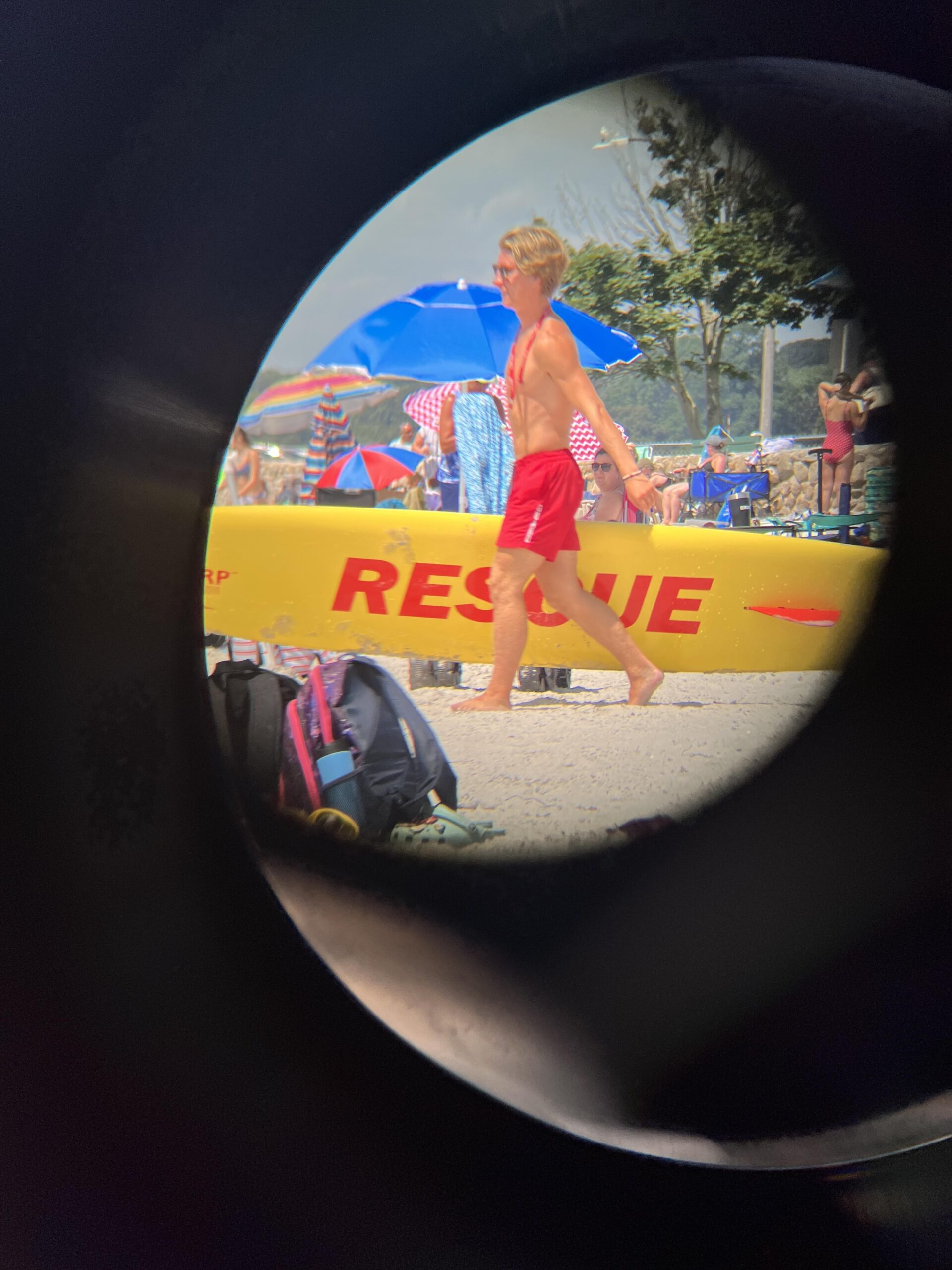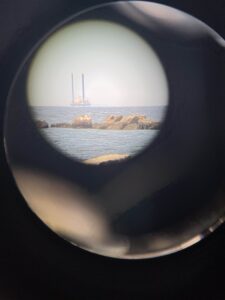
THIS is How it Happens
I was lucky enough last week to go to the beach where I grew up, on the CT side of LI Sound. It was a perfect day: very warm, with enough breeze for relief, bright sun, and mid-week so the crowds were not crazy.
And I saw something new offshore – a big derrick with what seemed like a dredger. I asked a few people on the beach, including the lifeguard, and no one knew specifically what it was there for. But the local paper wrote it up soon after as the start of building offshore wind turbines. Looks like most will be off the coast of RI and not where the derrick is currently anchored. I am in the FB group for that beach and I saw a photo (mine is below, through my binocs) and I read through some of the posts to find many in support. A few were not, and I had a powerful response to the berating of offshore wind “mills” due to how it has already killed off the fish, fowl, and other life along the shore.
Well.
 I grew up in SE CT, and was on the beach and in the water from as early in May as possible through afternoons of September and weekends in October until I was done with college and moved away in the early 1990’s. The life started leaving the Sound decades ago. I have seen it from my near daily face-down in the water position with masks and snorkel as this is how I lived and loved LI Sound for most of my childhood and teenage years. This mixed with body surfing in rough weather, carrying a book out to the raft on calm and boring days, or kayaking in the made-in-our-basement three-part kayak that I named “Discovery”.
I grew up in SE CT, and was on the beach and in the water from as early in May as possible through afternoons of September and weekends in October until I was done with college and moved away in the early 1990’s. The life started leaving the Sound decades ago. I have seen it from my near daily face-down in the water position with masks and snorkel as this is how I lived and loved LI Sound for most of my childhood and teenage years. This mixed with body surfing in rough weather, carrying a book out to the raft on calm and boring days, or kayaking in the made-in-our-basement three-part kayak that I named “Discovery”.
In my first decade of life, I saw and felt life In the sea: blackfish, flatfish, pipefish, rock crabs, sand crabs, blue crabs, phosphorescent watermelon jellyfish (and icky stinging red jellies), starfish, hermit crabs, snails. I found live moonshells, quahogs, razor clams, steamers, lobsters, and conch that reluctantly opened their doors if you were very, very patient. I was often surrounded by eel grass, and I loved the stringy fibrous veins in it. I could slightly pull apart sections and it looked like they were separate, but they still moved together, tied by these fibers. Did you know seagrass was used as insulation in Gillette’s Castle? Occasionally we had sand dollars show up, and I even saw a sort of ray once, flying away from me under the surface. Horseshoe crabs were an infrequent and exciting encounter. Once someone line-caught a sand shark (after beach hours) right where we swam! We had kelp, and bladder grasses and sea lettuce that I tried a few times to dry and eat and enjoy. I found collars created of sand and some secretion that served to shelter fish eggs until they hatched. I caught those aforementioned rock crabs by dangling broken muscles into the crags of the levy and then I sold them for 2 cents apiece to Spicer’s Marina as bait so I could buy ice cream sandwiches from the snack shack. All of this because I looked, underwater, and marveled.
In my second decade the pipefish disappeared, and starfish became rare. I still saw hermit crabs and built them little craggy rock houses. I learned to dive deep at the raft and I caught lobsters now and then for a weekend meal, always making sure they were big enough and not carrying eggs. I also snagged my fair share of clams for homemade chowder. I speared a few larger fish, once a decent blackfish, but I never learned to scale or cook them. We also would eel fish in the Thames River, and eels were great skinned and simply fried in butter.
I now use my snorkel and mask more to hunt for golf balls than to seek underwater life.
In my third decade I started to see the eel grass retreating and the sea lettuce nearly went away. Kelp appeared only after serious storms. We had more bladder seaweed on the rocks and more of the stringy brown/red clumps that look like puffballs until you pull them out of the water. They then look like red jellies and are good for throwing at friends to scare them. I saw fewer fish, and I stopped seeing rock crabs on the levy. More gulls, though, which doesn’t really compute until you think of all the food the beachgoers hauled in with them. Gulls love free processed chips, crackers, and oil fried anything. I did see a new fish, very small, one with little paddle fins on each side. But in a few years that one went away as well.
In my fourth and fifth decades I have gone to the beach less, which is heart wrenching. But life is nearly gone for the Sound in that area. No flatfish, no pipefish, lots of red jellyfish some years. I saw, this past time, a school of little guppies, and one fish about 4-5 inches long which might have been a grouper or maybe a small blackfish, but it was swimming away quickly in an incoming tide which was stirring up the water and clouding it. That’s it. That’s all I saw. I now use my snorkel and mask more to hunt for golf balls than to seek underwater life…there is at least one house near the beach that loves to drive golf balls into the water. One day I scored nearly 20.
All of this is background to illustrate that wind turbines and the prep and the installation of them are certainly NOT the reason life is leaving our LI shores. This is not really how it happens. It’s the tons of little and mostly unintended abuses that aggregate and kill. Death by a thousand insults. The reasons cover the last 4-6 or more decades and include:
- Toxic-laden sunscreen – only came into fashion a few decades ago and only recently did we realize how oxybenzone and octinoxate are killing our oceans. Be smart – find reef safe or ocean safe sunscreen, please. It’s killing our seas. Oh, and possibly harming you while protecting you from sun cancer (ironic). Studies still pending.
- Motor boats and jet skis, especially the ones using fossil fuel. The leakage is terrible. Think also about the impacts of the high-speed (and slow speed) ferries.
- Cleaning agents used on said boats – the stuff we wash down our cars and decks and boats with is crazy!
- How about the fossil-fuel powered beach rakers that, yes, clear the beaches of seaweed, but destroy nesting sights and damage washed-up flora and fauna in the process?
- All of the little bits of plastic, the straws, the chip bags, the cigarette butts, the micro-plastic in face-scrubs (not a brilliant idea, ever).
- Golf balls – just sayin’.
- What about the detergent we wash our bathing suits in, the massive amounts of perfumes and lotions and deodorants, the makeup that all washes off un into the sea.
- Dredging for submarine launching and passage – oh, and for the Coast Guard Eagle, and the sub-tender.
Some of these will continue – I can’t see Groton not having submarines anytime soon. Some are changing, now, like the sunscreen – you can certainly find reef-safe brands if you look. All of them and more have caused damage, possibly irreparable damages.
It’s the tons of little and mostly unintended abuses that aggregate and kill. Death by a thousand insults.
 The off-shore wind turbines are one piece of a very complex and long-view transition that is occurring to slow some of the damages our lifestyles have created. Yes, we need to own this. So, instead of condemning one aspect of our needed energy transition, let’s help it out by finding ways we can change our personal practices to help Nature heal, so she can continue to help us. We need all the layers of our lives to be more intentional, and we need to understand broader impacts of our actions. And certainly we need as many who can to take it to the next step – advocate for change in your city, along your shoreline, and in your community. We seriously are all in this together.
The off-shore wind turbines are one piece of a very complex and long-view transition that is occurring to slow some of the damages our lifestyles have created. Yes, we need to own this. So, instead of condemning one aspect of our needed energy transition, let’s help it out by finding ways we can change our personal practices to help Nature heal, so she can continue to help us. We need all the layers of our lives to be more intentional, and we need to understand broader impacts of our actions. And certainly we need as many who can to take it to the next step – advocate for change in your city, along your shoreline, and in your community. We seriously are all in this together.
And I miss the pipefish.
It is certainly possible 2bgreener,
Jodi
Be the first to like this post (no login required)
